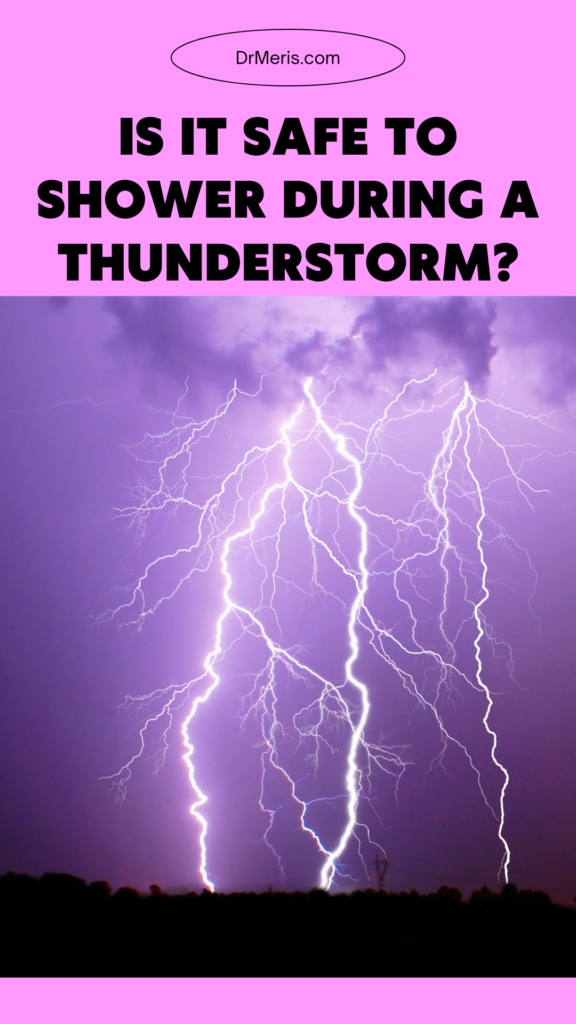The National Weather Service reports that the chance of being hit by lightning at any given time in your life is 1 in 15,300.
You might have heard that it’s unsafe to take a shower when there’s a storm. But, is it really dangerous to shower during a thunderstorm?
Taking a shower or bath during a thunderstorm isn’t a good idea because you could get an electric shock if lightning hits a building and travels through the water pipes.
The CDC, says you should skip showering, bathing, and any other water-related activities when there’s a storm.
About one-third of lightning strike injuries occur indoors, so even if you’re safe inside, you still need to be careful.
To stay safe inside when it’s storming, avoid anything that has to do with water pipes or anything that plugs into an outlet.
So why is it risky to shower during a thunderstorm? How to stay safe? Let’s explore everything you need to know about the safety of showering during a thunderstorm.

What is lightening?
Lightning is a spark of electricity that happens when there’s a big difference in charge between storm clouds and the earth, or even within the clouds. The vast majority of lightning happens up in the sky.
“Sheet lightning” refers to a far-off spark that lights up the whole bottom of a cloud. Other sparks might look like beads, ribbons, or rockets.
When storms are brewing, the clash of rain, ice, or snow particles in the clouds makes the charge difference between the clouds and the ground bigger, and often gives the lower parts of the clouds a negative charge. Things on the ground, such as trees, and the ground itself, get a positive charge, setting up a charge imbalance that nature tries to fix by allowing electricity to flow between the two.
Lightning is super hot—a bolt of lightning can heat the air around it to five times hotter than the sun’s surface. This intense heat makes the air quickly expand and shake, which is what we hear as the booming thunder that follows a lightning strike.
Any actions that bring you into contact with water pipes or flowing water during a thunderstorm could increase the risk of electrocution, including doing the dishes and washing your hands.
Why is it not safe to shower during a thunderstorm?
Should lightning hit a structure, it could pass through the water pipes. Taking a shower during a thunderstorm could heighten the chance of getting electrocuted.
This danger is more pronounced with metal pipes compared to plastic ones, but it’s still recommended to stay away from any plumbing fixtures or the flow of water during a thunderstorm.
How common is it to be hit by lightening while showering?
There are stories out there of people getting zapped by lightning while showering. Even though it’s rare, it can happen because most plumbing systems use metal pipes, which can let electricity flow through them. If lightning hits a building or the ground nearby, the electricity can make its way through the pipes and possibly shock someone in the shower.
What else to avoid during a thunderstorm
So it’s advised to stay away from water and plumbing systems, even if you’re indoors during a thunderstorm. Other precautions to take during a thunderstorm include the following, as stated by the CDC:
- Being outside: Remain indoors during a thunderstorm. If you’re outside, look for a safe place to take cover.
According to the National Weather Service, no place is completely safe from lightning strikes, but certain areas offer significantly more protection than others. The safest spot during a thunderstorm is found within a big, covered building that has plumbing and electrical systems. This encompasses malls, educational institutions, workplaces, and individual homes.
- Being near windows: Keep a safe distance from windows or doors. It’s best to be in a room on the ground floor if possible.
- Using electrical appliances: Avoid using any electrical devices that are plugged in, like a TV or computer.
- Using a landline: Stay away from wired phones. Cordless and mobile phones are usually safe to use.
- Hanging out under a tree: Lightning could strike a tree, or strong winds during a storm might cause a tree or its branches to fall.
- Resting against a concrete wall: Concrete structures might have metal pipes or wiring inside, which could conduct lightning.
- Lying down on the ground: Electrical currents from lightning can travel through the ground during a storm.
- Standing near a body of water: Get out of the water and stay clear of lakes, swimming pools, oceans, or seas during a thunderstorm.
How to remain safe during a thunderstorm?
The National Weather Service provides the following advice to help you stay safe during a thunderstorm:
- Head indoors: It’s not safe to be outside during a thunderstorm, so try to get indoors as quickly as you can.
- Locate a safe spot: If you can’t get inside, look for a secure place, like a car.
- Stay indoors: Remain inside a building and avoid using porches or balconies. Stay inside until at least 30 minutes after the last thunderclap.
If you’re outside without any safe place to go, you can take the following steps to lower your risk of getting hurt during a thunderstorm:
- Get down from any high places, such as mountains, hills, or slopes
- Don’t seek shelter under cliffs or overhangs
- Don’t lie flat on the ground
- Don’t stand under single trees or tall structures
- Stay away from all bodies of water
- Stay away from anything that could carry electricity, like metal fences, barbed wire, power lines, or windmills
- If you’re outside in a thunderstorm and can’t find a safe spot, crouch down low and roll into a ball. Place your feet close together, tuck your head, and cover your ears.
What to do if someone get shocked by lightning?
If someone gets an electric shock during a thunderstorm, call for emergency assistance right away. Cordeless and mobile phones are safe to use for this purpose.
If the person who was shocked isn’t bleeding, move them to a safe area, like away from showers and other plumbing systems, to reduce the risk of getting shocked again.
Once you’re in a safe spot, check the person for any other injuries. If the person isn’t breathing or doesn’t have a pulse, the CDC recommends doing mouth-to-mouth resuscitation and chest compressions until emergency services arrive.
Conclusion
Showering during a thunderstorm is dangerous. Should lightning hit a water pipe or the earth around it, the current might flow through the pipes. This could lead to electrocution if you’re in the shower or using the water.
The risk of being electrocuted by lightning is minimal. Yet, the more water you use, the higher your risk. It’s also recommended to stay away from using devices connected to sockets and to stay indoors during a thunderstorm.
Read also:
Is it Safe to Eat Sprouted Potatoes?
Sign Up for Our Email List
Get our latest articles, healthy recipes, tips, and exclusive deals delivered straight to your inbox with our newsletter.
We won't send you spam. Unsubscribe at any time.








